Introduction
The oil and gas industry's land management practices have long been plagued by challenges such as manual processes, scattered information, and difficulties in overseeing land assets. However, the landscape is undergoing a transformation, driven by regulatory frameworks, technological advancements, and the need for effective stakeholder engagement. This article explores the benefits of implementing oil and gas land management software and highlights its core features, including database management, GIS and mapping capabilities, land access and obligation management, financial integration and accounting, real-time data analytics, compliance and risk management, and successful case studies.
The article also provides insights into selecting the right software and best practices for its implementation. These advancements in land management software are revolutionizing the oil and gas industry, enhancing operational efficiency, decision-making, and sustainability efforts.
Challenges in Traditional Land Management
The oil and gas industry's approach to land management has historically been fraught with challenges. Cumbersome manual processes, scattered information, and difficulties in overseeing land assets have been the norm, leading to inefficiencies and delays that hamper decision-making. However, the landscape is transforming due to various factors.
Regulatory frameworks like the National Environmental Policy Act (NEPA) and its state equivalents, such as CEQA, have introduced measures that slow down development, adding years of delay and significant compliance costs. This shift is intended to heighten standards for new projects and address environmental concerns but also results in an increasingly complex and costly landscape for land management.
In the context of public lands and waters management, the federal government, through agencies like the Bureau of Land Management (BLM) and the Bureau of Ocean Energy Management (BOEM), oversees a vast expanse of acreage for multiple uses, including oil and gas production. As of 2022, the industry holds over 34,000 leases on public lands, amounting to more than 23.7 million acres, and more than 12 million acres in public waters. The concentration of these leases among a handful of companies further complicates the scenario, with the top 20 companies operating onshore accounting for over 40 percent of these leases.
In the private sector, hydraulic fracturing negotiations reveal a complex web of landowner interactions and compensation models. Energy companies must navigate the reluctance of landowners who may be concerned about health risks or are holding out for better compensation or are simply unreachable. These negotiations are crucial as pooling multiple mineral claims is essential for the economic viability of drilling operations, highlighting the need for strategic planning and collaboration.
Advancements in technology have significantly altered the exploration and extraction methodologies. With innovations like 3D seismic imaging and advanced drilling techniques, the industry now employs a more scientific approach, leading to increased efficiency and a higher rate of success in exploration activities. This data-driven strategy contrasts sharply with the past reliance on geological surveys and educated guesswork, which often resulted in the risk of drilling dry wells.
Furthermore, cross-industry learnings are becoming increasingly important. For instance, the oil and gas sector's experiences with methane management offer valuable insights for agriculture and waste industries, underscoring the potential for collaborative progress towards environmental goals.
These developments indicate a dynamic shift in land management within the oil and gas industry, influenced by regulatory measures, advancements in technology, and the need for effective stakeholder engagement and negotiation strategies.
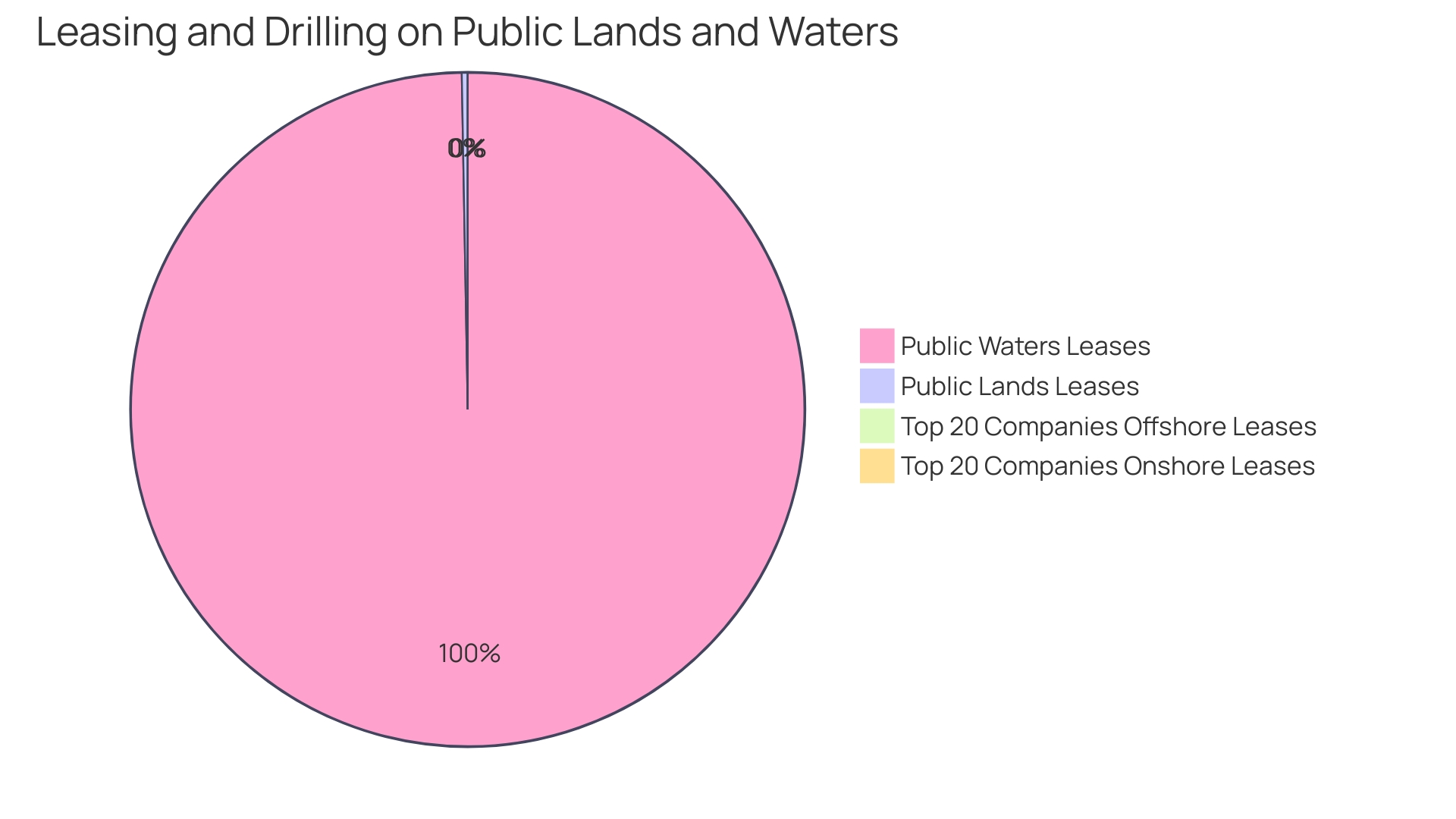
Benefits of Implementing Oil and Gas Land Management Software
In the dynamic realm of the oil and gas industry, which stands as the world's eighth largest, the incorporation of advanced land management software is revolutionizing operations. Recognizing the challenges posed by volatile oil prices and the intensive nature of industry labor, companies are leveraging technology to expedite processes and mitigate risks. For instance, the utilization of Bluebeam software is one such digital innovation that is reshaping the landscape, allowing businesses to significantly enhance efficiency.
The software is instrumental in centralizing critical data, enabling real-time updates, and fostering seamless collaboration across all levels of operation. The result is a marked improvement in decision-making capabilities, a reduction in operational expenses, and a notable increase in overall productivity.
Amidst the overwhelming complexity of data management in shipbuilding, an essential component of the oil and gas supply chain, digital solutions like Bluebeam are proving invaluable. Geert Schouten's insight into the construction of a pipelayer—a vessel type integral to the industry—reveals that a single project can involve upwards of 630 million data elements, spanning tens of thousands of documents and 15,000 drawings. Software solutions effectively monitor and streamline this immense information flow, ensuring that each data point is accounted for and managed with precision.
The strategic application of such technology is a testament to the oil and gas sector's commitment to the Fourth Industrial Revolution (4IR), marked by innovations like AI, Machine Learning, and IoT. These advancements are not only enhancing operational efficiency but are also instrumental in addressing crucial global challenges such as climate change and energy sustainability. As SLB's initiatives indicate, the deployment of cutting-edge technology and systems is critical to reducing emissions while satisfying the world's growing energy demands, all while working towards the overarching goal of achieving net zero emissions and transforming the energy landscape.
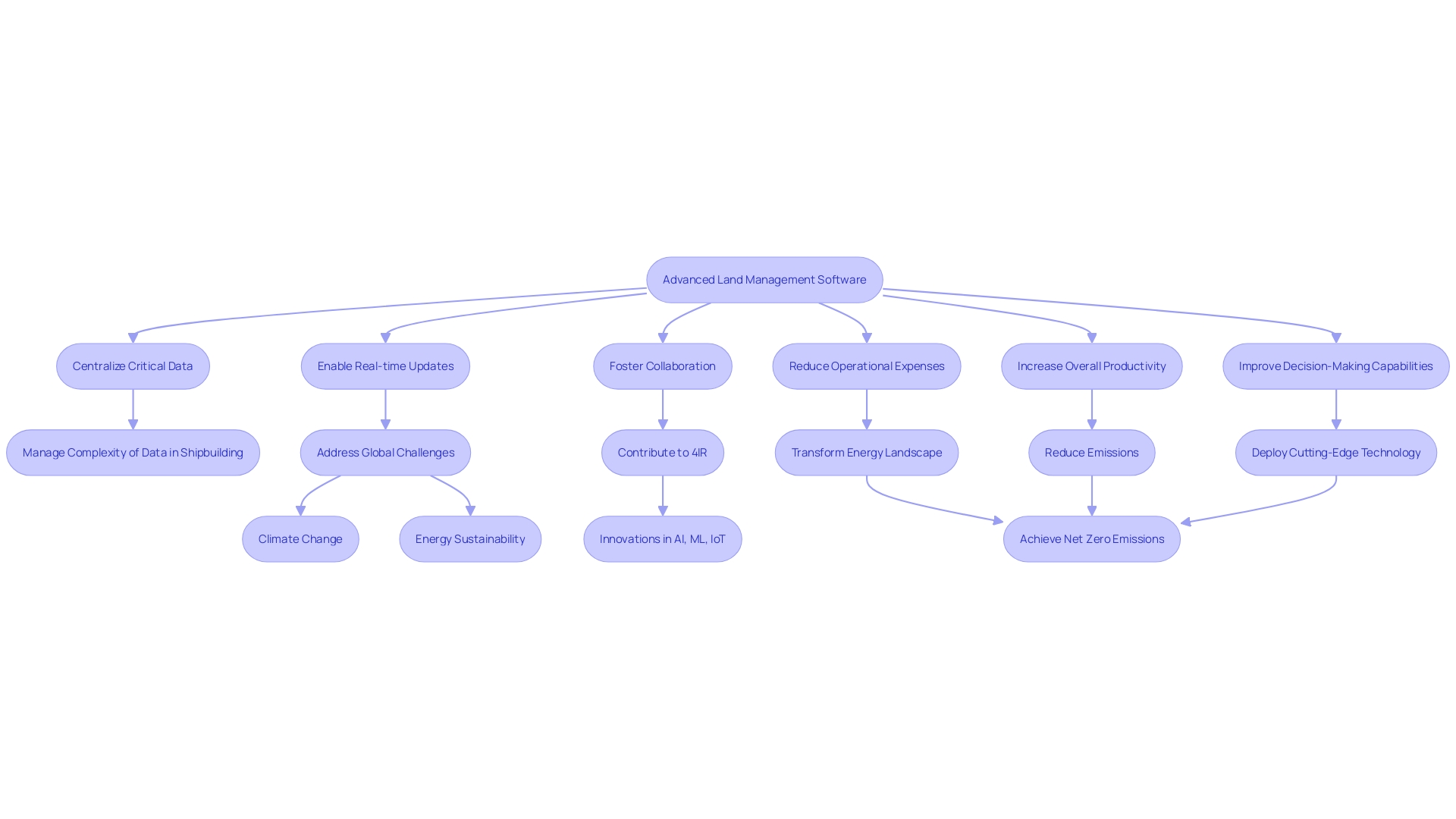
Core Features of Oil and Gas Land Management Software
As the oil and gas industry navigates an era of digital transformation, propelled by the need for cost reduction and efficiency gains, land management software has become an indispensable tool. This industry-specific software is engineered with features that address the unique challenges and demands of oil and gas operations. It includes robust database management systems that ensure the integrity and accessibility of crucial data.
Integrated GIS and mapping capabilities provide a visual and analytical view of land assets, essential for strategic planning and decision-making. Managing land access and obligations becomes more systematic, ensuring compliance and mitigating the risk of legal disputes. With financial integration and accounting modules, the software enables seamless financial operations, aligning with industry accounting standards.
Moreover, real-time data analytics afford companies the ability to make informed decisions swiftly, a critical advantage in a sector where timing can significantly impact project success and profitability. The adoption of these advanced digital solutions, as evidenced by companies utilizing Bluebeam software to enhance workflows, demonstrates a commitment to innovation and a competitive edge in a rapidly evolving industry landscape.
Database Management and Data Integration
Advancements in oil and gas land management software have revolutionized the way companies handle land-related data. At the heart of this transformation is a comprehensive database management system, designed to streamline the storage, organization, and retrieval of critical land data. This system ensures that data integrity is maintained while enabling real-time access and updates.
Seamless integration with other corporate systems and databases is a cornerstone of this software, fostering an environment where data is effortlessly synchronized, keeping it current and accurate.
In a sector where data is a critical asset for informed decision-making, the implications of efficient database management are profound. Christina R. Fritsch of The National Law Review highlights the staggering cost of bad data to US companies, amounting to upwards of $3 trillion annually. Effective data management and integration tools become indispensable in mitigating these losses by eliminating human error and providing reliable insights.
The evolution of database management systems, dating back to the 1960s with the development of the Integrated Data Store (IDS), has set the stage for today's sophisticated tools that enable organizations to handle large volumes of data with precision. The integration of these systems with AI and Big Data analytics further enhances their capability, allowing for the detection of patterns and optimization of performance autonomously.
The strategic management of data across various environments and for multiple purposes underscores the complexity of data in the oil and gas industry. Messaging software and AI-powered tools facilitate the dynamic flow of data, ensuring it serves the multifaceted needs of production, analytics, and operations. In the context of environmental responsibility, such as the COP 28 conference's focus on methane leak detection, these tools are pivotal in enabling companies to meet emission goals through precise monitoring and remediation efforts.
As oil and gas operations are often situated in remote locations, the ability to monitor and control facilities from a distance is a game-changer. This is evident in the way companies like Tecpetrol embrace a culture of integrity and transparency, leveraging technology to manage their energy resources effectively while fostering community development.
GIS and Mapping Capabilities
The oil and gas industry is increasingly leveraging Geographic Information System (GIS) and mapping tools to enhance their land management practices. These advanced technologies are proving invaluable for visualizing and scrutinizing vast tracts of land, including lease areas and existing infrastructure, within a robust spatial framework. By integrating various layers of data on these maps, companies can unearth critical insights, discern opportunities, and effectively manage risks.
These insights are pivotal for making strategic decisions about land acquisition, development, and ongoing maintenance operations.
For instance, in the realm of environmental conservation, organizations like the National Trust have successfully harnessed imagery data to examine landscape changes over time and assess features on their protected lands. This approach mirrors the methodologies that can be utilized in oil and gas land management, where similar spatial analysis techniques are applied for examining geological formations, pipeline networks, and potential new site developments.
Furthermore, the ability to monitor remote facilities and infrastructure in real-time is transforming how companies oversee their operations, regardless of geographical barriers. This is particularly pertinent for pipeline operators who now have the capability to detect methane leaks and manage pump operations from afar, employing internet-based applications that allow for a greater exchange of information and enhanced control systems.
These developments underscore the industry's shift towards a more data-driven and technologically sophisticated landscape, where GIS and mapping capabilities are not just supplementary tools but core components of a comprehensive land management strategy. Such advancements are facilitating a more efficient and informed approach to managing the complex web of assets and resources integral to the success of oil and gas companies.
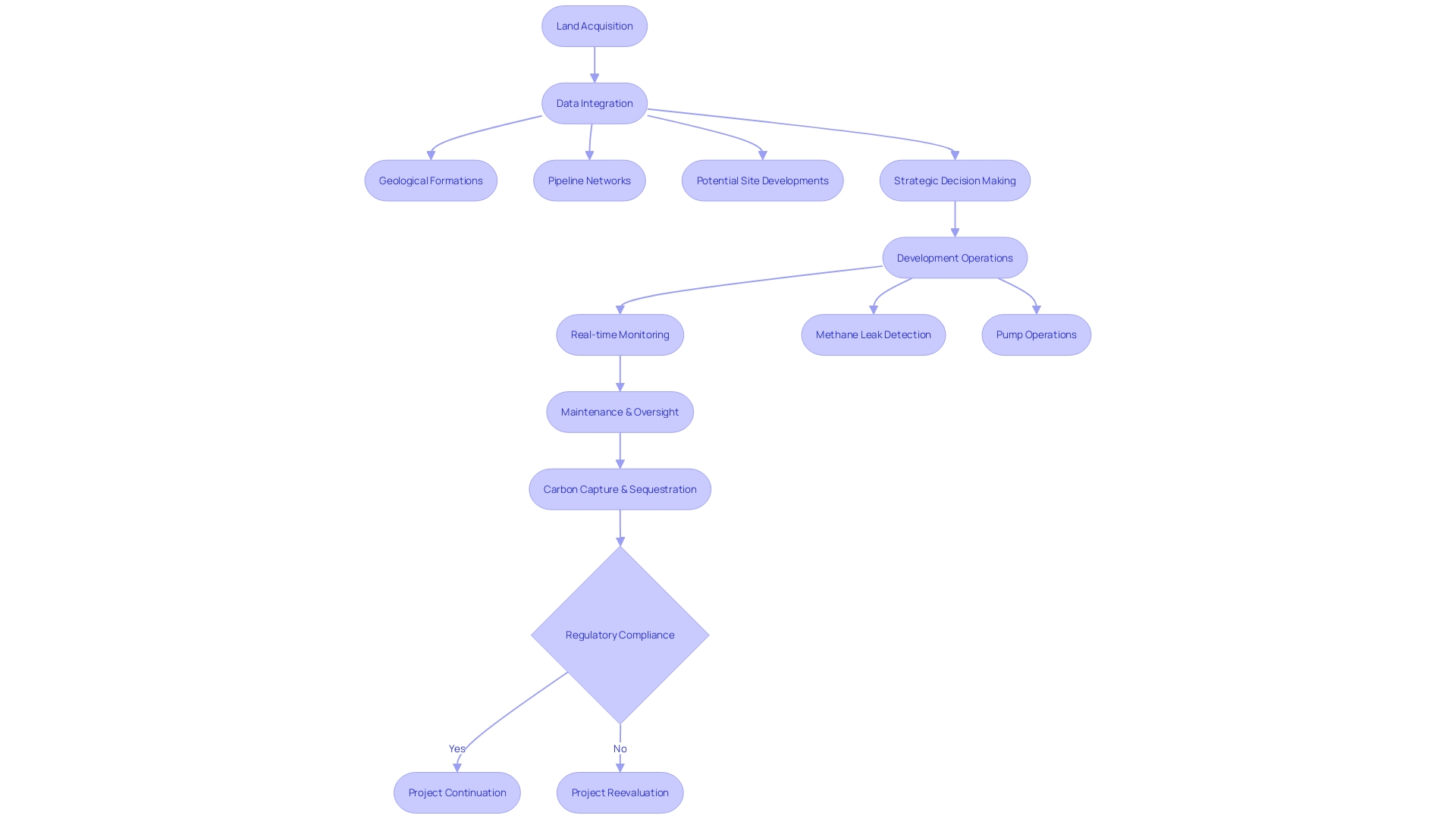
Land Access and Obligation Management
For oil and gas companies, the meticulous management of land access and obligations is not just a routine task; it's a strategic imperative. With the integration of land management software, these businesses can centralize and streamline the tracking and administration of agreements, leases, permits, and obligations. This technology not only facilitates the acquisition of necessary approvals but also ensures adherence to complex regulatory requirements, while keeping a vigilant eye on critical milestones and deadlines.
The energy sector is increasingly embracing digital transformation, as evidenced by companies like Tecpetrol, which operates across Latin America. As they commit to sustainable development and community engagement, these corporations are also adopting innovative solutions to enhance operational efficiency. For instance, using software for environmental and sustainability data management, companies have reported at least a 25% reduction in time spent on data validation and internal audit processes, highlighting the software's impact on automating and simplifying complex tasks.
Furthermore, the oil and gas industry is at a pivotal juncture with the energy transition, seeking to balance energy production with environmental concerns. With the sector accountable for a significant amount of global CO2 emissions, there is a pressing need for technologies that can drive performance while reducing the carbon footprint. The implementation of software solutions is a step towards this, offering a platform for improved stakeholder engagement and decision-making.
As the world transitions towards cleaner energy, the industry must also navigate the challenges posed by public land and water leasing, as noted by Nikki Martin, President of the EnerGeo Alliance, who emphasizes the urgency of releasing the backlog of permits to meet the growing energy demand. The utilization of land management software can thus play a critical role in this regard, enabling oil and gas companies to manage their leases more effectively and respond to the dynamic energy landscape.
In conclusion, the adoption of land management software is proving to be a vital tool for the oil and gas industry, not only in enhancing operational efficiencies but also in contributing to sustainable practices and meeting the evolving demands of energy production and management.
Financial Integration and Accounting
In the dynamic landscape of the oil and gas industry, where financial precision is as crucial as geological accuracy, the integration of land management software with financial systems has become indispensable. Such advanced software solutions not only facilitate meticulous tracking of financial transactions linked to land assets—including lease payments, royalties, and tax obligations—but they also herald a new era of financial process automation. This innovation significantly enhances auditing processes, guarantees precision in financial reporting, and elevates the overall financial stewardship of the company.
The significance of this technological integration is underscored by the experiences of industry leaders like Tecpetrol, which not only harness energy from geological sediments but also actively engage in community development and environmental protection. Tecpetrol's commitment to sustainability and governance, as detailed in their Global Sustainability Report, reflects the broader industry trend towards responsible energy management and adherence to ethical standards.
Moreover, the oil and gas sector's rapid evolution, powered by the Fourth Industrial Revolution, has seen a seismic shift from traditional exploration methods to a data-driven approach underpinned by AI, IoT, and advanced robotics. These transformative technologies enable companies to optimize operations and reduce the environmental footprint, aligning with global efforts to combat climate change.
As the industry navigates through a period of robust demand and complex production dynamics, the integration of land management software with financial systems stands as a testament to the sector's adaptability and forward-thinking ethos. It embodies the intersection of financial acumen and technological prowess, ensuring that the companies remain competitive and responsible stewards of both economic and natural resources.
Enhancing Decision-Making with Real-Time Data
Harnessing the synergy of artificial intelligence (AI) and Big Data, modern oil and gas land management software has revolutionized the way industry professionals approach data analytics. With machine learning algorithms, these advanced systems autonomously identify patterns, optimize performance, and facilitate continuous learning to refine operations without explicit programming. This has elevated the capability to track and manage land assets, leases, obligations, and financials with unprecedented precision and efficiency.
The real-time analytics provided by these software solutions not only generate immediate insights but also allow for sophisticated data visualization and reporting. Consequently, this empowers stakeholders to discern trends, evaluate risks, and seize opportunities swiftly, ensuring strategic advantage in a competitive landscape.
In particular, the integration of IoT and real-time systems has expanded the operational scope, allowing for remote monitoring of assets and the seamless multi directional flow of information across vast distances. This is exemplified by the digital transformation of the Abqaiq plant, where AI and Big Data infrastructure have significantly improved operations. Smart drones and robots now perform a substantial portion of routine tasks, machine learning algorithms fine-tune oil stabilization processes enhancing power generation, and predictive modeling proactively addresses potential system failures.
Such advancements underscore the critical role of real-time data analytics in driving operational excellence and sustainability in the oil and gas industry.
Improving Compliance and Risk Management
In the high-stakes realm of the oil and gas industry, adherence to stringent regulatory standards and risk mitigation is not just a priority—it's a necessity. The emergence of sophisticated land management software has become a linchpin for companies striving to maintain regulatory compliance and manage their risks effectively. This technology is engineered to streamline compliance processes by automating checks, staying abreast of regulatory changes, and facilitating the generation of precise reports.
By implementing such systems, companies are empowered to better manage their land assets, leases, and contractual obligations, which is crucial in safeguarding against legal entanglements and financial setbacks. As the industry embraces the digital revolution, marked by the ever-growing importance of data management and Internet of Things (IoT) applications, these software solutions become vital tools. They allow for the remote monitoring of operations, the aggregation and analysis of seismic data, and the tracking of personnel, regardless of location.
This digital leap is not just about improving efficiency; it's about harnessing the power of data—often reaching into the realm of hundreds of millions of data elements for complex projects like shipbuilding—to ensure that every aspect of operation aligns with safety and success. The utilization of digital twins and simulation software further enables engineers to anticipate how assets will perform, ensuring the longevity and reliability of crucial infrastructure. In an industry where a single oversight can have monumental consequences, the strategic integration of land management software within the broader safety management systems and culture of an organization is indispensable.
It's about focusing on what must go right and ensuring that every component and action needed for successful execution is thoroughly understood and managed.
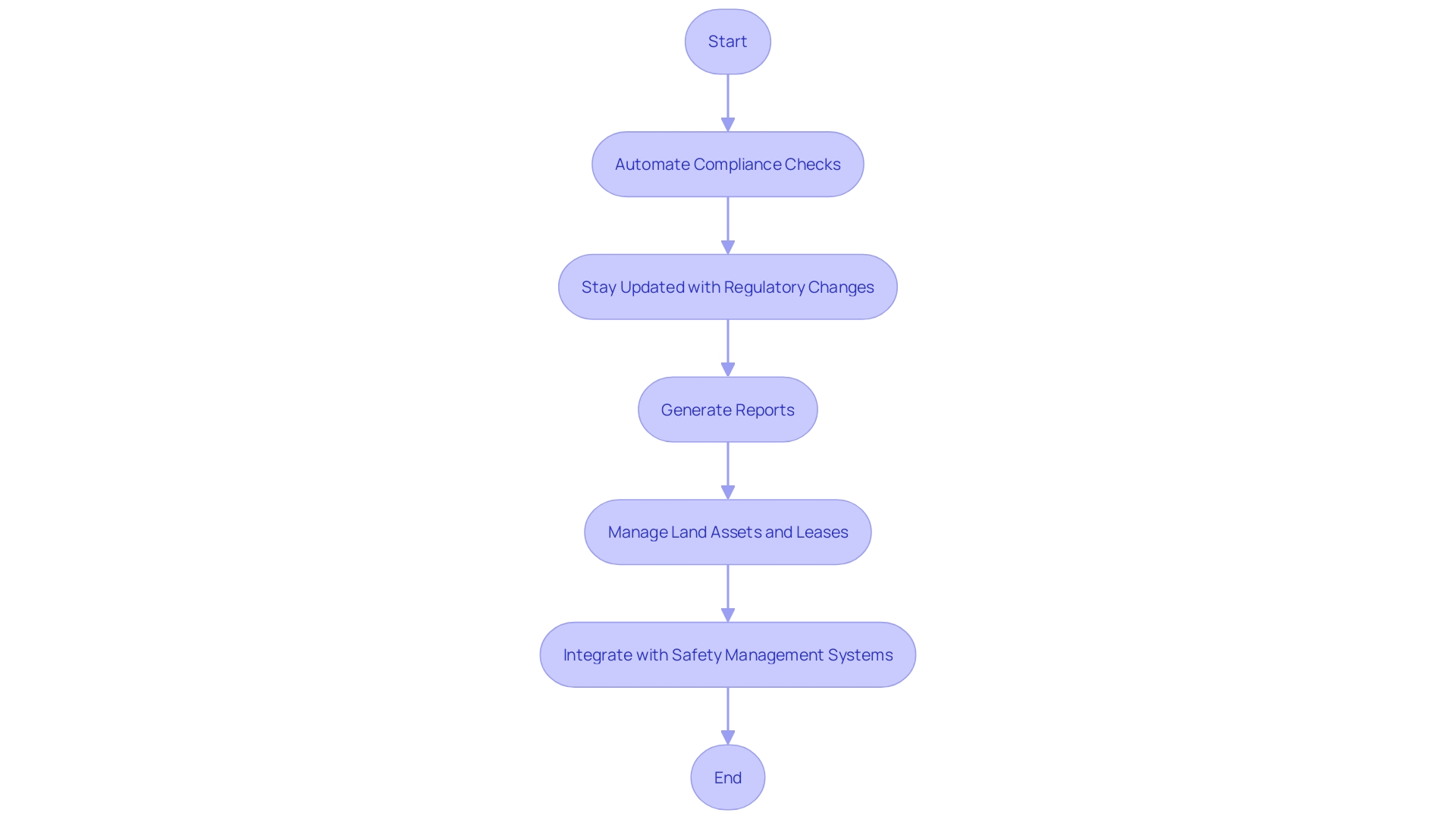
Case Studies: Successful Implementation of Land Management Software
Innovations in land management software are transforming the oil and gas industry by bolstering operational efficiency and decision-making. A salient example is Enterprise Products, which illustrates the synergy of technology, data, and strategic partnerships. Their adoption of advanced systems ensures seamless operations and is a testament to the potential gains from integrating such technologies.
Real-world applications also include companies like WaterWipes, which partnered with Cimlogic to revolutionize their manufacturing execution systems, enhancing performance and quality through sophisticated software solutions. Elsewhere, proactive maintenance strategies, such as the use of recurring work orders, have been employed to maintain system integrity, preemptively addressing issues before they escalate.
These advancements are underpinned by the burgeoning Internet of Things (IoT), which connects devices to the internet, enabling real-time data transmission and sharing. IoT's influence is evident in smart city applications, from street lighting to waste management, which are expected to proliferate, with smart meter adoption predicted to reach 76% in Europe and 90% in North America by 2027.
The oil and gas sector can also leverage Smart Building Automation Systems (BAS) to achieve energy savings between 8% and 15%. These systems dynamically adjust energy consumption based on occupancy and other factors, leading to considerable long-term savings.
Furthermore, the strategic selection and implementation of Field Service Management (FSM) software can propel small businesses to new heights. FSM enhances coordination between the headquarters, warehouses, and field staff, optimizing job orders, payments, fleet tracking, and more, bringing about a heightened level of automation and efficiency.
In the context of the Fourth Industrial Revolution, marked by a fusion of physical, digital, and biological technologies, the oil and gas industry is poised to benefit from breakthroughs in AI, robotics, and IoT. These technologies not only streamline operations but also offer solutions to global challenges like climate change and inequality.
As the industry advances, simulation software is increasingly vital for power grid modeling, enabling engineers to evaluate the grid's capacity to support new energy resources. With the advent of digital twin models, operators can predict equipment failures and proactively make necessary upgrades.
The collective impact of these technological strides is reshaping the landscape of the oil and gas industry, showcasing the profound benefits of digital transformation and serving as compelling case studies for those contemplating the transition to advanced land management systems.
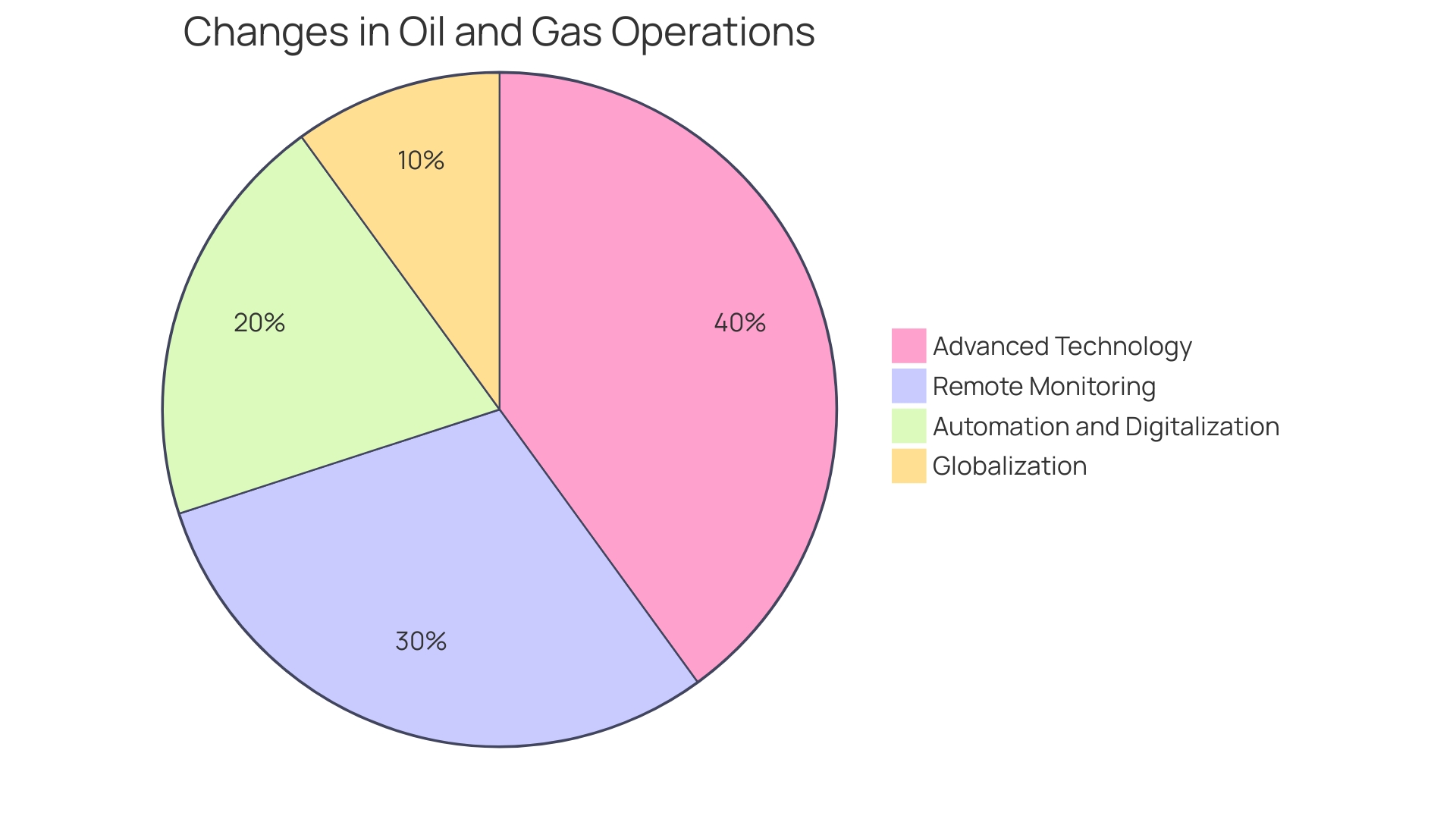
Selecting the Right Oil and Gas Land Management Software
Selecting the optimal land management software for the oil and gas industry is a pivotal decision that can significantly influence operational efficiency and cost-effectiveness. Crucial considerations include the software's ability to scale with business growth, its user experience design, and the capacity for integration with existing systems. Additionally, ongoing vendor support and the overall value for the investment are paramount.
By conducting comprehensive research, which might entail examining case studies like the one involving Cimlogic and WaterWipes, companies can gain insights into the successful deployment of management systems. Furthermore, considering the impact of the Fourth Industrial Revolution, it is advantageous to choose software that leverages cutting-edge technologies such as AI, Machine Learning, and IoT, which can offer a competitive edge in driving performance and sustainability in a sector responsible for significant CO2 emissions. Feedback from industry peers and experts, along with a thorough comparison of different software offerings, will guide companies toward an informed and strategic choice that aligns with their operational goals and addresses the complexities of land management within the oil and gas domain.
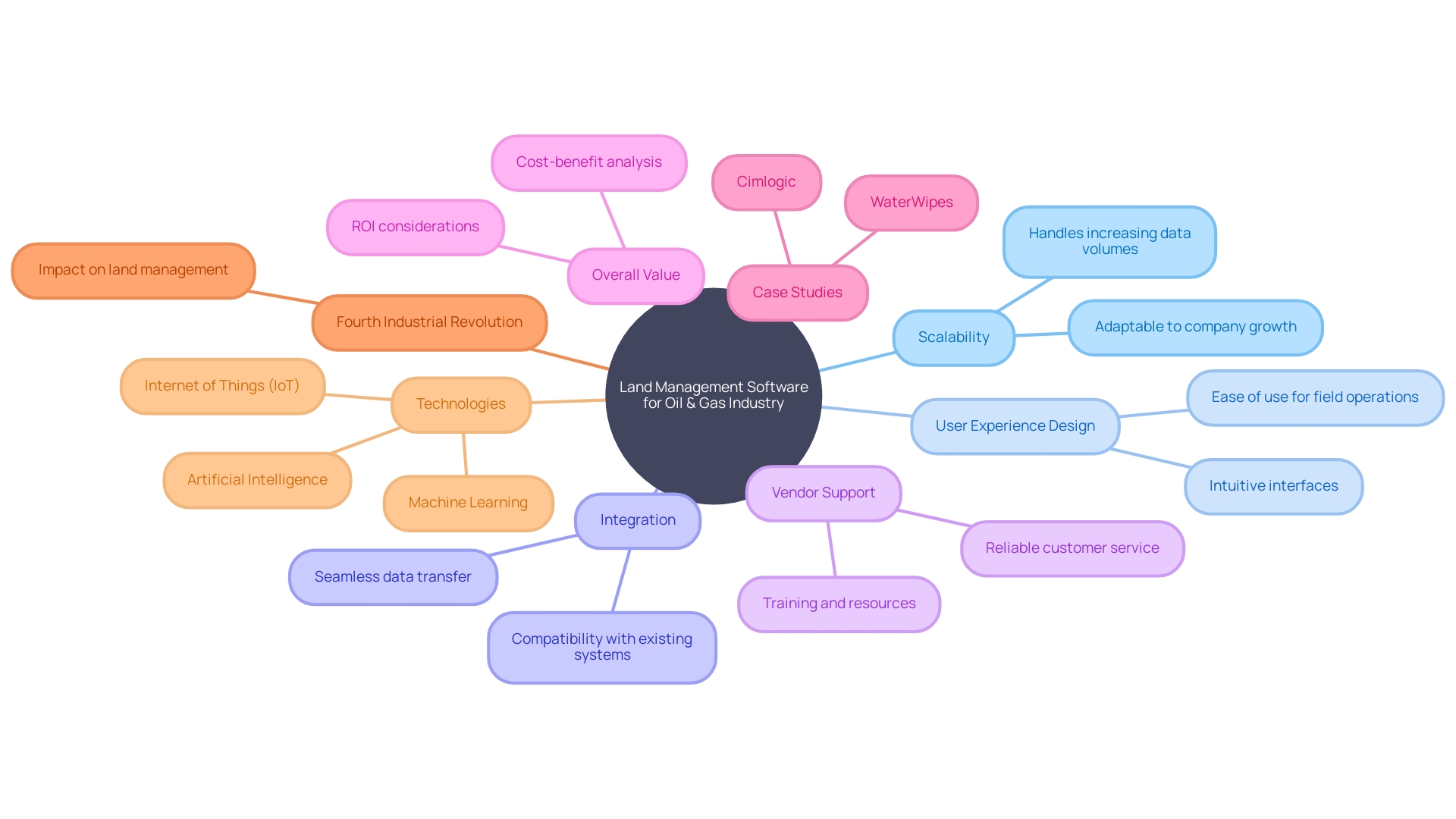
Best Practices for Implementing Land Management Software
Successful implementation of land management software is a critical component for modern land administration systems, offering a powerful tool for sustainable socio-economic and environmental management. To ensure the software delivers its full potential, it is essential to follow a structured approach that begins with a comprehensive assessment of needs, which can include examining data on deforestation causes or agricultural impacts. For instance, by utilizing satellite imagery, one can analyze the impact of various activities on land use and forest health, integrating this information into the software to enhance predictive capabilities and decision-making processes.
Defining clear objectives is the next crucial step. Objectives should align with the overarching goals of sustainability and the equitable use of open data, as highlighted by experts who emphasize the importance of accessible data to foster positive change. Involvement of key stakeholders, especially those from vulnerable populations, can prevent the risks of data inequality, ensuring that the software's benefits are widely distributed.
Furthermore, adequate training and support are vital to enable users to effectively harness the capabilities of the software. This involves not just familiarizing users with the interface but also developing their skills in data interpretation and application. Continuous monitoring and evaluation of the software's performance are imperative to ensure it meets the dynamic requirements of land management, such as adapting to evolving agricultural practices or regulatory changes.
By integrating these practices, such as those demonstrated by organizations that provide digital support platforms to farmers, land management software can become a transformative tool for the industry, guiding users through complex data analysis and enhancing productivity and environmental stewardship.
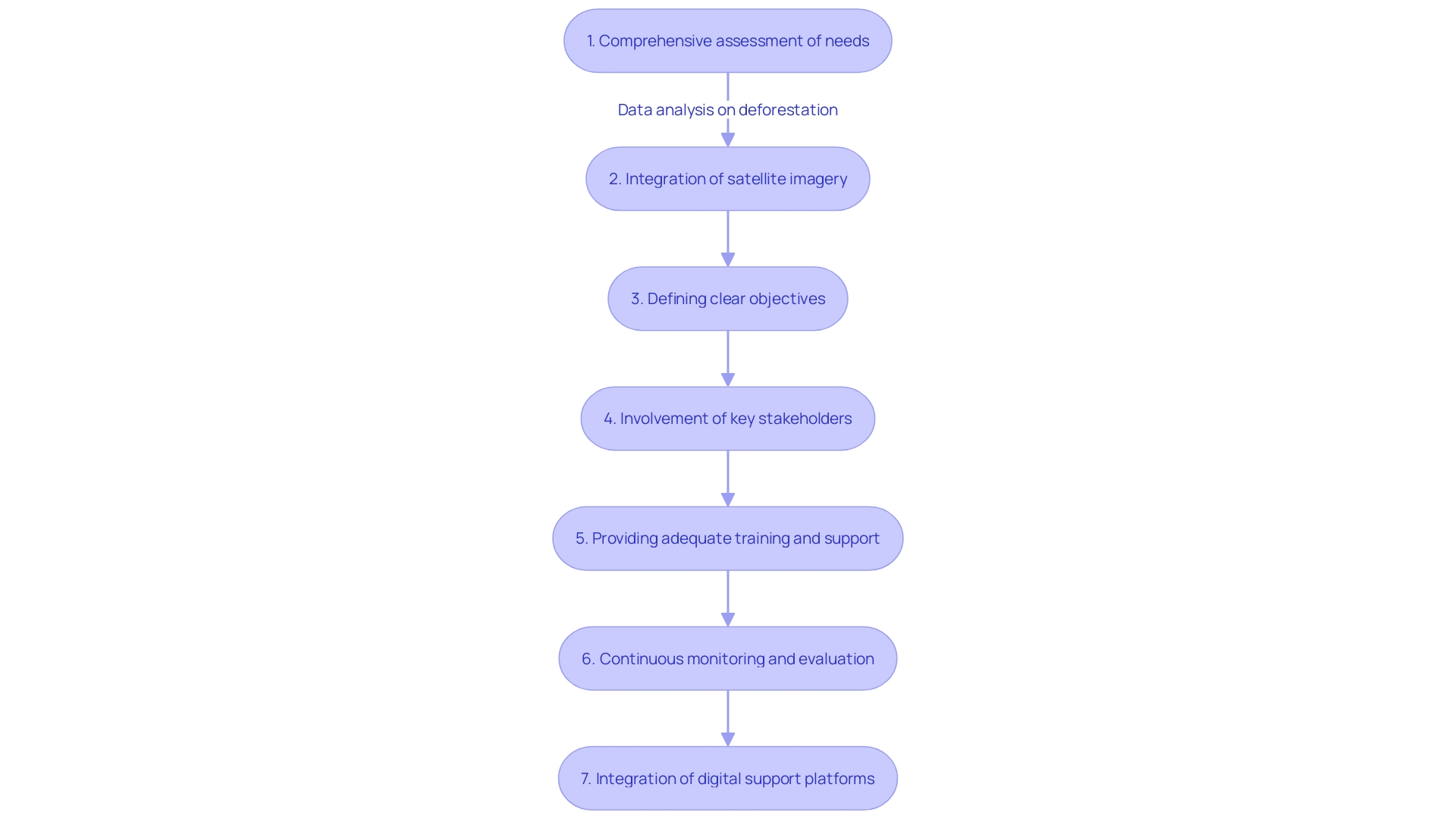
Conclusion
The oil and gas industry is undergoing a transformative shift in land management practices, driven by regulatory frameworks, technological advancements, and stakeholder engagement. Implementing oil and gas land management software offers significant benefits, revolutionizing operations, enhancing efficiency, decision-making, and sustainability efforts.
Key features of the software include robust database management, GIS and mapping capabilities, land access and obligation management, financial integration and accounting, real-time data analytics, compliance and risk management. These features streamline processes and improve operational effectiveness.
Database management ensures the integrity and accessibility of critical land data, while GIS and mapping capabilities provide a visual and analytical view for strategic planning. Land access and obligation management features centralize tracking and administration, ensuring compliance and mitigating legal disputes. Financial integration and accounting modules enable seamless financial operations, while real-time data analytics allow for informed decision-making.
Successful case studies highlight the positive impact of land management software on operational efficiency and decision-making. When selecting software, scalability, user experience, integration capabilities, vendor support, and value for investment should be considered. Best practices for implementation include thorough research, clear objective definition, stakeholder involvement, training and support, and continuous monitoring.
In conclusion, adopting land management software is vital for the oil and gas industry, enhancing efficiency, sustainability, and meeting evolving energy demands. By leveraging advanced software solutions, companies can optimize processes, make informed decisions, and ensure responsible land asset management. This technological transformation is crucial for success in a rapidly evolving industry landscape.




